Diseñando con la naturaleza y no contra ella: Entrevista a la arquitecta paisajista Linda S. Velazquez sobre la necesidad de una arquitectura verde en las ciudades
Spanish interview with Isabel de Felipe in Berlin, originally published by El País on July 17, 2017
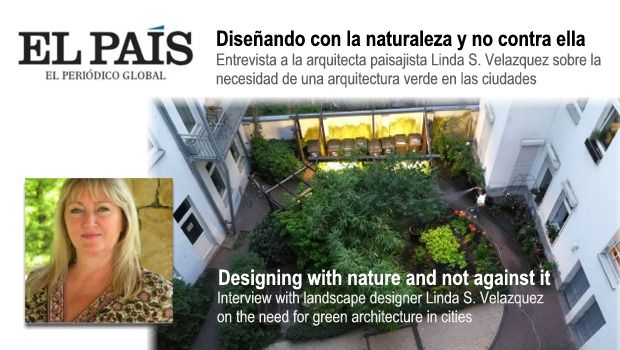
Designing with nature and not against it:
Translation of the Spanish Interview with Linda S. Velazquez in El País on the need for green architecture in cities
Under the header of “Urban Beings” in the “Green Cities” section, here’s my translation. Of course, they edited quite a bit and didn’t include all of my answers, but so be it.
NOTE: El País didn’t use any of the photos or graphics I sent, and in fact put one in of an interior courtyard landscape above – is it a greenroof? I don’t know. All of the photos below are my own placement!
Q & A Translation by Linda Velazquez
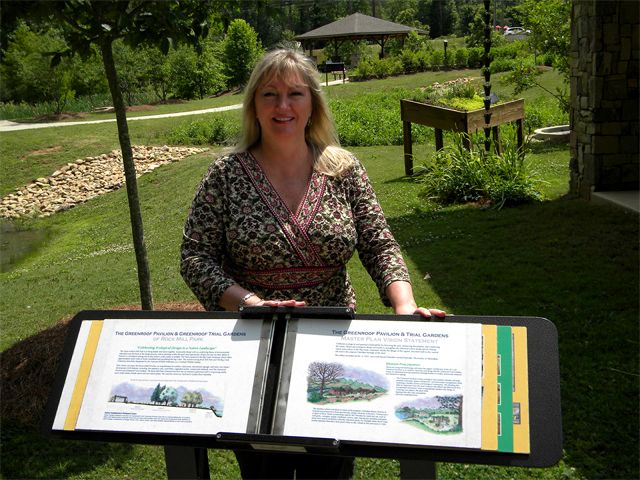
Here in Alpharetta, GA at Rock Mill Park where I designed the Greenroof Pavilion & Trial Gardens.
“Linda S. Velazquez is a member of the American Society of Landscape Architects (ASLA), GRP, LEED AP. She is also the founder and publisher of Greenroofs.com (1999) and design consultant at her company Sky Gardens Design (2004). Linda studied landscape architecture at the University of Georgia (2000).
Linda writes and reports extensively about greenroofs and living architecture and has presented across the globe. Linda’s role as Greenroofs.com publisher affords many opportunities to promote the industry. She has collaborated on numerous books including Green Cities in the World, Vertical Garden City: Singapore, and The Rise of Living Architecture, in addition to journals, magazines and online media.
Q: From your experience as a pioneer in the analysis and dissemination of urban green infrastructure, how do you perceive its evolution in the last few years?
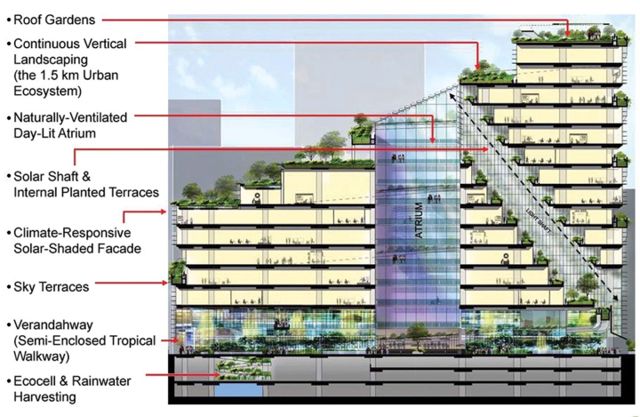
SOLARIS, Fusionopolis (Phase 2B), One North Singapore schematic by T. R. Hamzah & Yeang Sdn. Bhd., courtesy of Ken Yeang.
A. In my opinion, I believe our green architecture industry and market continues to grow each year because of the increasing general public interest and acknowledgement of important projects along with their associated multiple benefits – both public and private. We must also recognize the accomplishments of innovative leaders within the industry and design fields, businesses, and government at all levels who have promoted the idea and its progression further.
In the last 20 years we have seen dynamic and avant-garde designs that have drawn great attention to promote the greening of the planet with the integration of green: bioclimatic, biodiversity, biomimicry and sustainability. Of course, construction follows financial cycles and we had a few years with fewer projects completed, but many people around the world are interested in green technologies, whether renewable energy or low impact development including green infrastructure like greenroofs and walls, and much more.
Q: Who or what are the most dynamic elements? Architects, designers, entrepreneurs, institutions, NGOs …?
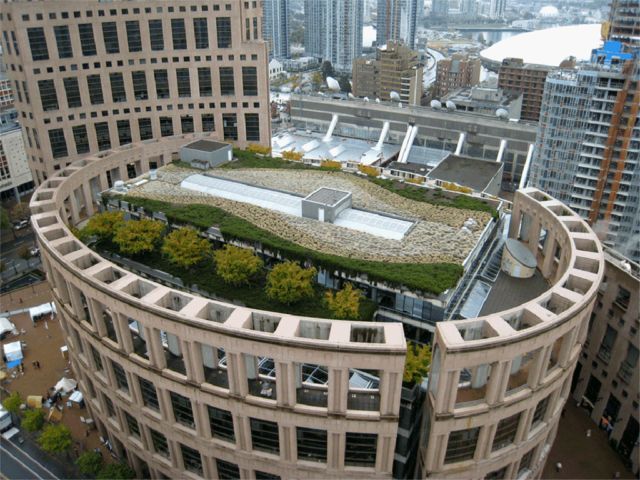
Vancouver Public Library, B.C., 1995. Currently under renovation, its new greenroof garden will be at grade with the existing maples. The top 2 floors will have a reading room, community event space, theater & public garden. Photo: American Hydrotech.
A: I think it has been a combination of experts, visionaries, and multidisciplinary professionals who have spread greenroof technology, at least here in North America. As for early completed projects, I would have to credit collaboration between architects like Moshe Safdie and landscape architect Cornelia Oberlander with the government of Vancouver, B.C. in Canada with its spectacular Public Library (1995, currently under a major renovation to create an accessible public roof garden space). Another innovative architect is William McDonough who worked with entrepreneurs such as the GAP in San Bruno, California (1997); the City of Chicago with its City Hall (2001), perhaps the most famous greenroof in the U.S.; and the Ford Motor Company with its River Rouge Truck Plant in Dearborn, Michigan (2003), which had the distinction of being the largest greenroof in the world for a few years, with 454,000 square feet.
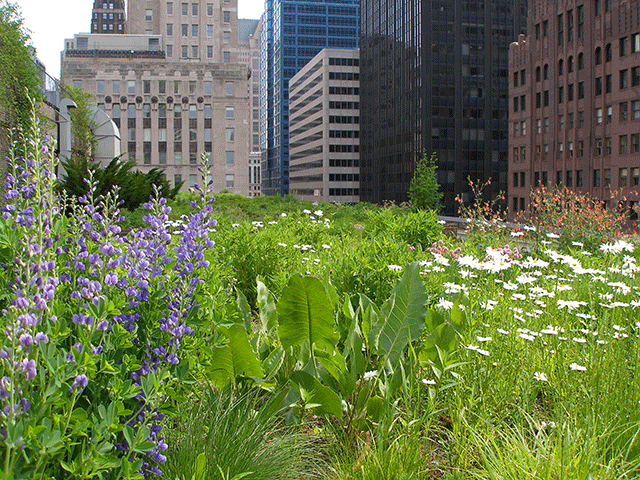
Chicago City Hall, designed by McDonough + Partners and a multitude of multi-disciplinary professionals. Photo courtesy of Charlie Miller and Roofmeadow.
In the United States in 1997/98 the pioneers who helped me tremendously were civil engineer Charlie Miller of Philadelphia, Pennsylvania; landscape architect Tom Liptan of Portland, Oregon; and the German environmental engineer Katrin Scholz-Barth who lived at that time in Minnesota. Also, ASLA began writing on the subject during that time frame and, with thanks, I began to discover and research further, culminating in Greenroofs.com in 1999.
Q. In your presentation at the WGIC Berlin 2017 Congress, you identified the 10 most recent trends in greenroofs and walls. What are the underlying market drivers?
A. Each trend in greenroofs and walls has several underlying factors depending on the location of the project: variables such as the needs and desires of the public and governments or the client / owner, what type of buildings are popular or necessary, different uses of a structure, aesthetic tendencies, the weather, the available products or materials, etc.
With Greenroofs.com’s annual compilation of the most popular trends, the “Top 10 List of Hot Trends in Greenroof & Greenwall Design” (since 2007), we try to highlight cutting-edge structures and designers who are outstanding, inspiring, and magnificent – underlined by the exceptional green vegetation covering the building.
Q. What effects can green infrastructure have on the population?
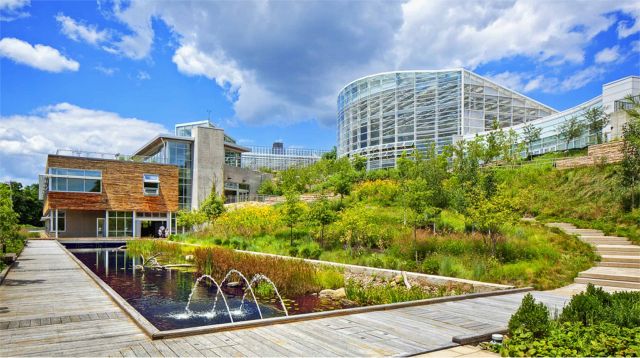
Phipps Conservatory and Botanical Gardens, Pittsburgh: 1st & only building to meet 4 of the highest green certifications: • Living Building Challenge, world’s most rigorous green building standard • LEED® Platinum — tied for highest points awarded under version 2.2 • 1st & only Four Stars Sustainable SITES Initiative™ for landscapes project (pilot) • 1st & only WELL Building Platinum project (pilot). Photo: Phipps Conservatory and Botanical Gardens.
A. Instead of using “gray” infrastructure such as concrete, asphalt, or hiding rainwater in underground pipes, detention ponds, etc., designing with nature instead of against it – using vegetation and natural ecosystem services – offers a multitude of beneficial opportunities and associated effects to improve a city or locale. The integration of nature into the urban fabric produces a wide spectrum of environmental benefits for the flora, fauna and human communities of our planet.
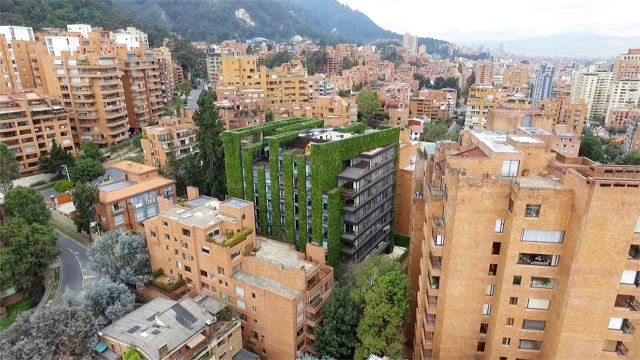
Santalaia in Bogotá, Colombia. Photo by Groncol.
Green infrastructure’s greatest potential lies in the ability to cover impermeable surfaces with permeable plant material. Using plants with engineering systems for stormwater management results in cleaner, fresher water and at the same time reduces the volume intensity that eventually falls on the streets. This immensely ameliorates a city, which is mostly impermeable, during heavy storms, when there may be overflows of the sewer system. Green infrastructure also reduces the urban heat island effect, which can dramatically increase temperatures due to lack of trees, plants, and green areas in cities, affecting the health of many people.
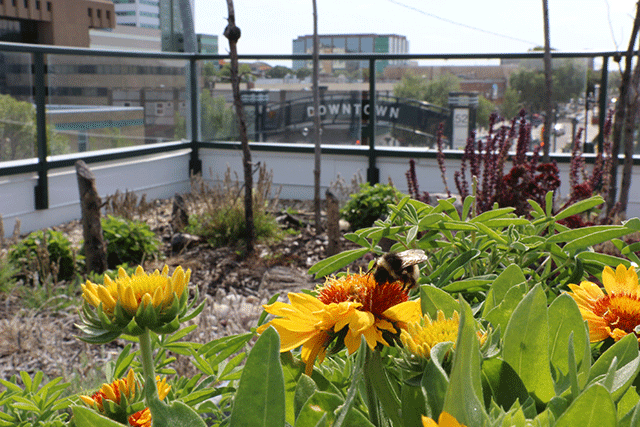
Berry Architecture Office Building Green Roof, Red Deer, Canada. Bumblebee feeding on Gaillardia sp. overlooking downtown, September 2014. Photo by Cynthia Pohl.
We can re-introduce native or sometimes even endangered plants by planting roofs and walls and green facades. At the same time, this attracts wildlife back to our cities like bees, butterflies and birds. We all know that seeing and being in nature is beneficial to human beings because of biophilia, the innate attraction in our biology to connect with nature. For example, nature helps us psychologically, improves the recovery of patients, and we rejoice within its natural and open spaces.
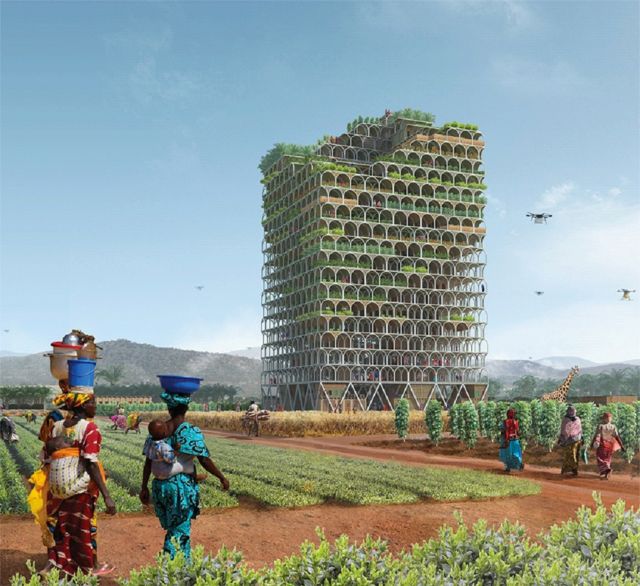
Mashambas Skyscraper, a mobile educational center for Swahili, Africa: eVolo 2017 Skyscraper Competition Winner by Pawel Lipinski and Mateusz Frankowski.
The creation of green spaces in a city is extremely important but sometimes there is no where to build a park or vegetable garden. Why not put it on top of a public building? And we must not forget that sometimes the green infrastructure costs much less than the gray infrastructure because we are using natural systems. If the cost of building a greenroof, for example, is more expensive at the outset, it has to be understood that life-cycle costs will reduce the final cost because of lower replacement costs because it will last double, triple, or perhaps even longer. Also, the use and energy costs of the building will decrease while at the same time a fifth facade has been created for the building – a new roof or wall space previously not utilized for the use of the owner or the public.
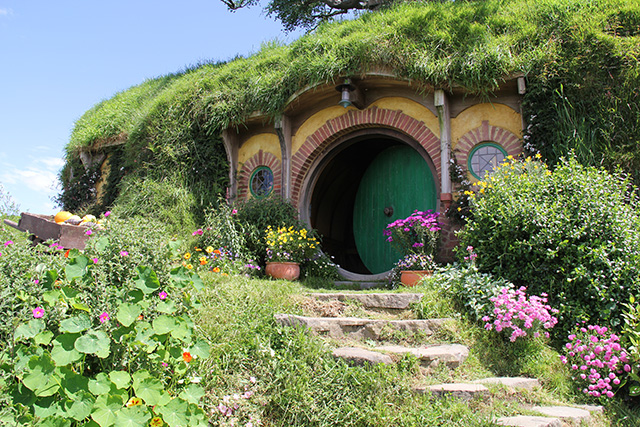
J.R.R. Tolkien’s vision of the idyllic Middle-Earth village home in The Shire. Frodo’s Home, Hobbiton Movie Set, Matamata, New Zealand, October, 2014. Photo by Linda S. Velazquez.
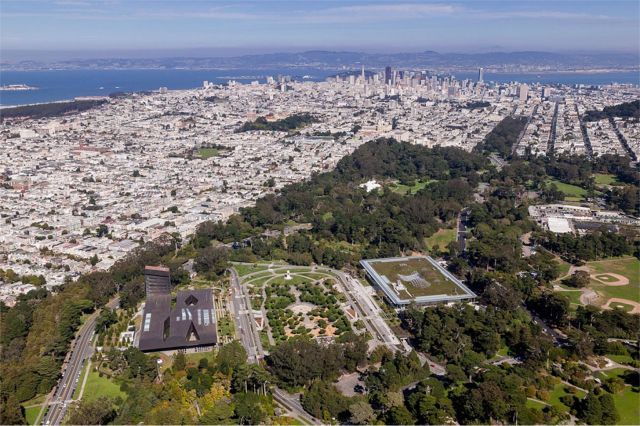
The World’s 1st & largest Double LEED Platinum Museum: California Academy of Sciences (CAS) Living Roof in San Francisco. Photo by Tom Fox, courtesy of SWA Group.
Finally, using a variety of low impact development techniques can reconnect people with nature. When all the environmental, aesthetic, emotional, and economic benefits are added, we can see that green infrastructure offers sustainability benefits to many. Implemented on a local or intermediate scale, green or biophilic architecture can improve the health and well-being of a community, country, and our planet Earth.
Q: With your international vision, what are the most dynamic cities in the implementation of green infrastructure and what are their drivers?
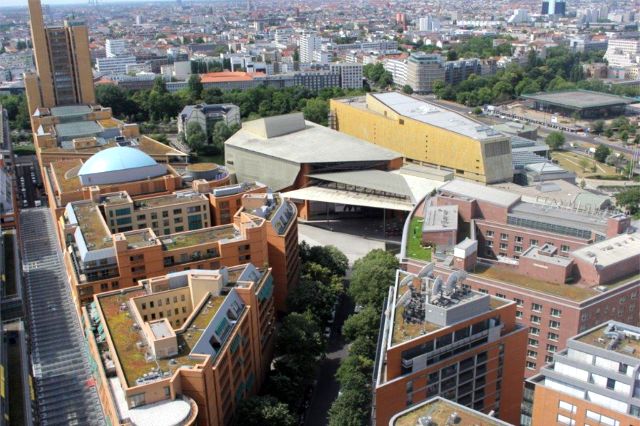
Potsdamer Platz in Berlin – a glowing example of green infrastructure! Photo by Linda S. Velazquez, June 2017.
A: It is impossible to talk about the most dynamic cities and not start with Germany in general, since many cities like Berlin, Munich, Stuttgart, and others have been leaders for the last 50 years. At least 48 German cities provide financial support for greenroofs. Around 35% have integrated greenroofs as part of their regulation, establishing around 86 million m2 of greenroofs which represent 14% of the total roof area of Germany. And they have established professional associations and organizations for the study of materials and best practices, such as the FLL (Forschungsgesellschaft Landschaftsentwicklung e.V.), FBB (Fachvereinigung Bauwerksbegrünung e.V.), and DDV (Deutscher Dachgartner-Verband), to name a few.
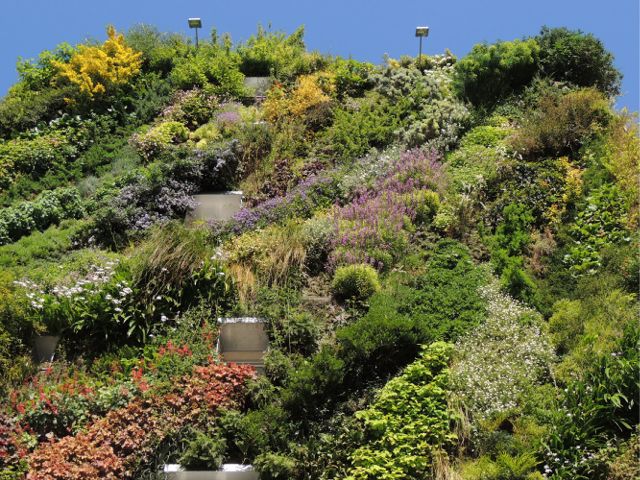
Oasis d’ Aboukir in Paris full bloom, one year after the plant installation, early April 2014. Photo courtesy of Patrick Blanc.
There are other numerous cities in the world that stand out with integrated green construction including Chicago, Basel, Portland, Toronto, New York, Linz, London, Paris, Mexico City, Shanghai, Washington, DC and the area, Milwaukee, Bogotá, and lately Madrid and Barcelona. American states like California and Pennsylvania have also done many projects. My favorite leader is Singapore, an island nation that currently has more than 720,000 m2 of greenroofs and over 50,000 m2 of green walls with plans for 2 million square meters of skyrise vegetation by 2030.
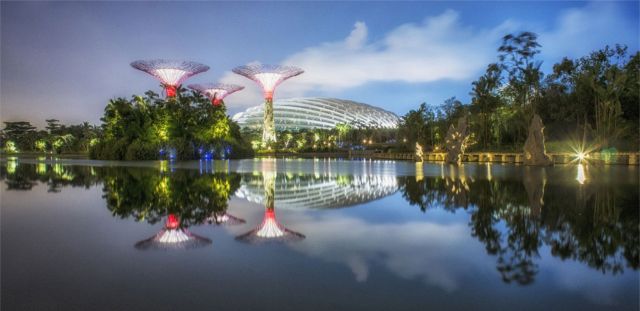
Gardens by the Bay, Singapore, by Grant Associates, Wilkinson Eyre Architects plus many more. Photo by Grant Associates.
Q: Could you provide some advice on measures we can take to improve urban dwelling?
A: We need to find or identify local leaders to talk about the topic of greenroofing and other greening opportunities and how to implement policies and strategies to encourage project stakeholders to build with green infrastructure. We still need to inform the public and various governments of the benefits so they understand the importance of protecting the natural environment and improving our construction practices using green infrastructure. As designers and other project principals we need to inform our customers why and how to do achieve this. And, we have to find ways to lower the prices of greenroofs and walls, either through industry or with the support of governmental incentives, tax exemptions, subsidies, etc. Green infrastructure should be considered first, whenever possible, within our built environment.
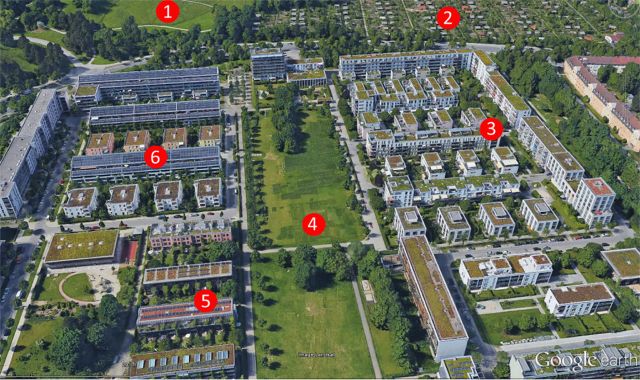
1. Munich development: Connected to large park. 2. Community garden allows people to grow flowers & vegetables. 3. Most roofs covered with greenroofs, most buildings have greened balconies. 4. Open space for socializing, typically above underground parking garages. 5. Solar Garden Roofs combine to max-out environmental benefits. 6. Houses are entirely covered with PVs. Photo courtesy of Green Roof Service.
Q: The well-being of city dwellers requires action in different fields. Could you give us your opinion on the importance of biodiversity, food security, a healthy environment, water management, energy savings, and creation of green spaces and recreation?
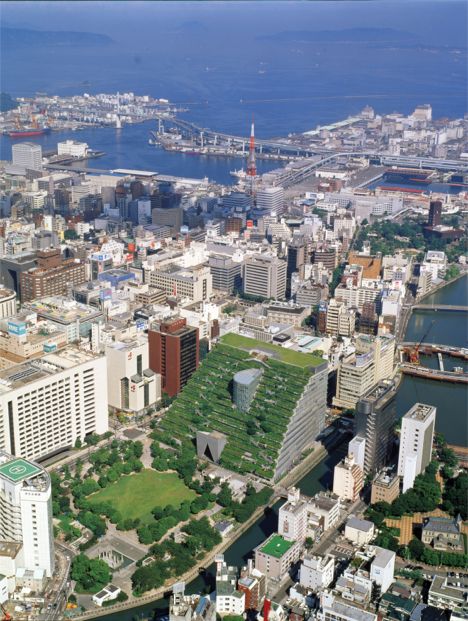
ACROS Fukuoka Prefectural International Hall by Emilio Ambasz & Associates, a perfect integration of green over gray.
A: My academic background is landscape architecture. We recognize that our Earth is limited in its natural resources, and we have to protect all of us: animals, plants, and humans. We are as one, living and sharing an ecology that is this planet. We must bestow the heritage of a healthy and sustainable land to our children, grandchildren, and great-grandchildren. The Earth is not ours to plunder, but our planet to sustain and protect for generations to come! With all my being, I believe that, in part, this is possible with architecture and design that is ecological and sustainable. Urban greening diminishes the effects of the built environment and promotes a strong and beautiful green infrastructure, flourishing and healthy.“
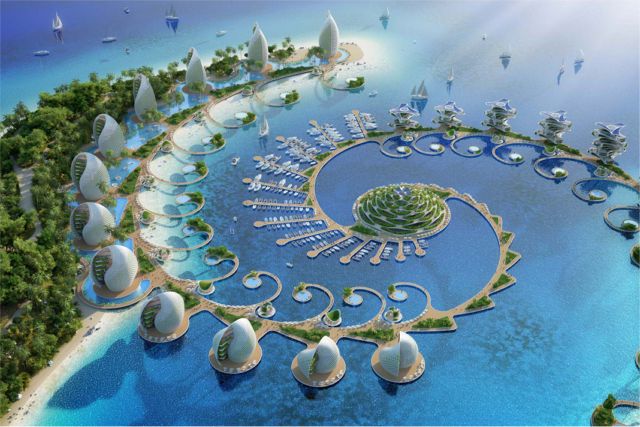
NAUTILUS ECO-RESORT Biophilic Learning Center: Zero-Emission, Zero-Waste, Zero-Poverty by Vincent Callebaut Architectures, Palawan 2017, Republic of the Philippines.
Author Isabel de Felipe

I’m honored to have been interviewed in Spain’s #1 newspaper, El País, by Isabel de Felipe, PhD and thank her for the opportunity!
Isabel is Professor Ad Honorem Polytechnic University of Madrid, on the Board of Directors for the Center for Innovation in Technology for Human Development, and has published numerous articles and books on urban greening and agriculture for development. Most importantly, she is a dear colleague of PRONATUR and WGIN.
Isabel and her husband Dr. Julian Briz participated in our second Greenroofs & Walls of the World™ Virtual Summit 2013 in the Spanish-language Panel “La Agricultura Urbana en Iberoamérica y España” – “Urban Agriculture in Iberia-America and Spain” along with Dr. José María Durán-Altisent, Tanya Müller García (Moderator), Dr. Gilberto Navas, and Joaquin Sicilia Carnicer – watch it on our 2013 Virtual Summit playlist.
If you’re a Spanish speaker, you can read Diseñando con la naturaleza y no contra ella yourself at in El País.
Contact Isabel at isabel.defelipe@upm.es.
 Greenroofs.comConnecting the Planet + Living Architecture
Greenroofs.comConnecting the Planet + Living Architecture






